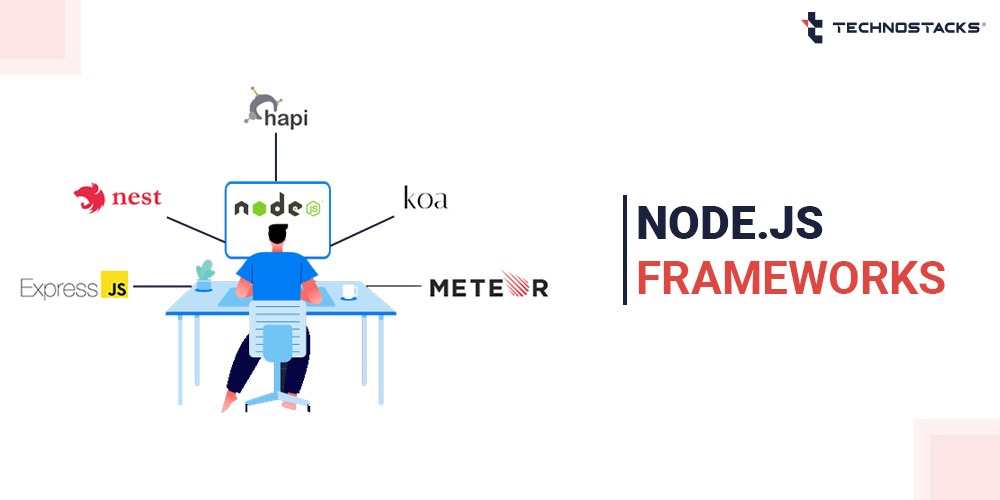Top Node.JS Frameworks for Web Development
The content on the most popular Node.js frameworks for web apps in 2025 is trending. Over many years experienced software developers have developed a quality enterprise node js framework that can get started with Node.js projects.
The best part is that all these Node.js frameworks are good enough for scaling, speeding the development process while also boosting performance across diverse projects.
With the rising demand, developers are also testing the different frameworks to use advanced features for building web applications.
As per the report of w3techs, Node.js is used by 2.1% of all the websites whose web servers we know.
The Best Node.js Frameworks for Web Development
So here is a highlight regarding the best Node.js frameworks for web development. Look at the features and convenience of using them.
1. Express.JS
Also known as Simply Express, the tool is quite popular with backend web development platforms. It is available in open-source free and under the MIT license Framework. Node.js finds use by at least 20 million websites. Reports show 1 percent to 2.2 percent usage of Node.js that gives incredible support to developers.
The launch of one of the best node js frameworks 2025 was for building web applications and APIs with the help of user-centric-based solutions. Today this framework has got plenty of features.
Features
- The fastest node js framework provides a robust set of the features that can ensure flexible development of web applications.
- It allows developments in the integration of the instant API.
- It also ensures the creation of server-side tools.
- The delivery of the excellent outcomes of the development process is amazing.
When to use it?
You can consider developing the web apps faster with the Framework because it has readily available API integration. It is the best suitable for enterprise-grade or browser-based App because of the templating robust routing security features alongside the error handling options.
When not to use it?
Express.js has a lot of complex programming that becomes a tedious task for beginners to build an efficient API.
2. Hapi
The famous open-source web application Framework is accessible to users for free. It will ensure the highly secured attributes and also has the inbuilt plugins with it.
One of the top Node.js frameworks is well known for creating the REST API, desktop applications, proxy servers, to name a few. Besides, it can exclude the challenge of unauthorized middleware.
Features
- It comes with a range of built-in extensions.
- The high support on behalf of the plugins makes the task easier.
- Cycle models available with it offer extensive assistance.
- The minimal overhead with the secure defaults gives continued support to the developer.
- Fast and easy bug fixing is an amazing approach.
- It has compatibility with MySQL, MongoDB, and similar other databases.
- With it, you can get the default authentication and input validation.
When to use it?
Hapi is good enough for the development of secure real-time scalable and social media applications. Thus, developers use it for the building of the proxies and API service.
When not to use it?
Some developers may face issues due to the Code Readability. So, if there’s a necessity to speed up the development process, one shouldn’t use Hapi.
3. Sails.js
The “convention over configuration” tenet is adhered to by the Node.js MVC (model-view-controller) framework known as Sails.js. It is the best Node.js framework for backend development. You may quickly create REST APIs, single-page apps, and real-time (WebSockets-based) apps with this framework, which takes inspiration from the well-known Ruby on Rails web framework.
It heavily utilises code generators, which let you create your application with minimal writing of code, especially for common stuff that can be scaffolded.
Features
- It is Express.js-based.
- WebSockets are supported in real-time by it.
- It follows the principle of “convention above configuration.”
- It has strong code generating capabilities because of Blueprints.
- Thanks to its potent Waterline ORM/ODM, it is database independent.
- In the same project, it allows several data stores.
- It is well documented.
When to use it?
A thin framework called Sails is placed on top of Express. Its collection of compact modules functions as a whole to give Node.js apps simplicity, ease of maintenance, and structural norms. With the help of this framework, you may create unique chat applications because of its precise, optimised data and reusable middleware functionalities. This is due to Sails’ limited versatility as compared to Express’s high-end customization.
When not to use it?
Sails.js do not keep your project’s security needs in mind, which could have major consequences. For almost a year, the website sailsjs.org broke all inbound Google links (such as “sails views,” “sails models,” etc.) as well as around 60,000 of the own automatically produced links. Although Rachael Shaw has already been working hard to remedy them once more, it was disappointing that information was so difficult to locate for such a long time. The request parser sleeps for 50ms for POST and PUT requests that transfer JSON or form-url encoded data. On our servers, this nap took up roughly 30% of the requested time, and in controller tests, it took up 50% to 70%.
4. Socket.io
The full-stack Node.js platform makes use of many programming languages. The preferred choice of the developers ensures solving the major and complex issues in web app development using Socket.io.
According to stackshare.io, more than 1400 companies use Socket.io as tech stacks for their web applications.
Socket.io solves issues with the help of a simple and clean API.
Features
- The real-time analytics gives high-speed support.
- The durability of the web and the app development process it gives make it stand out.
- Integration of the chat app proves to be the major challenge, but developers overcome the challenges easily with the utilization of this tool.
- It keeps tracking modifications as well as additional functionality.
- The auto-identification of the errors and correcting them becomes easier.
- There are similar APIs available for client and server-side development.
When to use it?
The developments of real-time applications like chat room applications, multiplayer games, video conferencing, and similar others get some good results with the utilization of Socket.io. Besides, you can also develop applications that require WebSocket development.
When not to use it?
Contrary to popular belief, Socket.IO is NOT a WebSocket implementation. It does require WebSocket as transport and adds additional metadata to each packet. WebSocket client cannot be successful in connecting to a Socket.IO server. Besides, the Socket.IO client will not be able to connect to a plain WebSocket.
Also read: Best Javascript Frameworks
5. Meteor.js
The framework is completely specific to JavaScript and uses only one language. It works in the form of an open-source database to a Framework that is good enough for the automation of changes to the client without the efforts of the developers. As per the report, Approx 75,303 websites are Meteor Customers, and 30,046 live websites are still using Meteor. Besides, it is comfortable with the variant of the device operating system that comes inclusive of Android.
Features
- Meteor.js works as a cross-platform Framework that can ensure Rapid building prototyping with CLI.
- The scope of getting the superfast interactions with the easy integration with other frameworks makes it stand out. Solution with the easy integration with other frameworks makes it more accessible to even the newbie developers.
- With it, you can get extensive community support and the open-source Framework.
When to use it?
If the developmental team is good to go with JavaScript, this is one of the best choices. It also turns out to be easy to learn and super fun for programming. You can use it for the building of the apps in no time since. The Framework can give you the same code that is right for the web app for mobile app development. Access to the live updates on the installed apps becomes easier without restricting the ongoing user session.
When not to use it?
Meteor ensures transporting template, CSS, and JavaScript code to the client. That said, it involves a few seconds for the first-page rendering. The framework proves to be more suited for a web application than a website.
6. Koa.js
The Express team has created a new web framework called Koa that seeks to offer a more compact, expressive, and reliable base for web-based applications and APIs. Using async functions may eliminate callbacks and dramatically enhance error handling in Koa. Although Koa does not have any software at its core, its appealing assortment of techniques makes constructing servers much easier.The main feature of Koa.js is that it employs ES6 generators, which means a program written with Koa.js will have very few follow-ups while using the asynchronous code we’ve grown accustomed to from Node.js in the background. Despite this, the code is significantly different and is much simpler, cleaner, and simpler to understand.
Features
- It was constructed using ES6 guidelines. ES6 makes it simpler to create any sophisticated programme because it has a lot of new classes and modules.
- Koa.js is less in weight than other Node.js frameworks. This aids in the creation of middleware that is lighter and more effective.
- Both the downstream and upstream flow of controls is facilitated, and it is utilised to make synchronous programming simpler.
- Koa.js enhances error handling by using components more effectively.
- Using context to combine the standard response and request objects into a single object is another benefit of Koa.js for developers.
When to use it?
Koa considerably enhances error handling and helps do away with callbacks through the use of asynchronous functions. Koa’s core does not include any middlewares. It offers a sophisticated set of techniques that expedites and enhances the server-making process.
The framework can create sophisticated apps with massive and knowledgeable development teams, especially for a significant project. But because it’s still developing within the community and therefore less well-liked, it could appear to be a challenging choice for newcomers.
When not to use it?
Koa is a fantastic alternative for creating HTTP services and online apps, but it isn’t always the ideal solution for all tasks. The very benefits that are advantages when dealing with some use cases turn into disadvantages, similar to every platform, languages, and even design pattern. It is necessary to evaluate the application of Koa case-by-case and only employ it when it is an appropriate fit for the specific project.
If you are unwilling to experiment with the more modern JavaScript ES6 syntax, Koa is probably not the best option for you. Koa was created for the contemporary web. Koa would not be appropriate if, for some purpose, your application has a strong obligation to use an earlier version of JavaScript.
7. Nest.js
A Node.js framework called Nest.JS is designed to be combined with TypeScript to create scalable and effective server-side applications. Strong HTTP server frameworks, such as Express or Fastify, are the key support for this web application. In addition to copying prior Node.js frameworks, Nest also fixes their shortcomings. Nest.JS is a much better option than ExpressJS when starting a new Node.js project because it is constructed using a simple, unambiguous design (controllers, modules, and providers). As a result, breaking down apps into microservices is a breeze.
Features
- Monoliths and Microservices were made easier to design with Nest.js.
- It’s easy to understand, use, and put into practise.
- It makes use of TypeScript, a pack of JavaScript and a tightly typed language.
- Strong Command Line Interface (CLI) to increase productivity and development simplicity.
- Numerous nest-specific modules are supported, making it simple for you to integrate with widely used technologies and ideas as Type ORM, Mongoose, GraphQL, Logging, Validity, Caching, WebSockets, and many others.
When to use it?
Our technical team selected Nest.JS because it satisfied their three main criteria, is extremely customizable, has rich reference, and has a large following. The benefit of utilising Nest is that you can specify your classes, integrity constraints, and description independently but yet within a single block of code, whereas establishing an API with the TSOA first appears to be pretty comparable.
When not to use it?
When your API arguments or answers are complex and require thorough documentation and validation. Although complex types (especially those with unions or inheritance) can be quite accurately represented with the help of existing decorators, doing so often necessitates using awkward workarounds.
Also read: Best NodeJS Libraries
8. Total.js
The Framework that offers a CMS-like experience is good enough in the Node.js environment. Moreover, the Framework is also available in different versions like CMS, HelpDesk, and Eshop. Get scope in the future IoT, REST services, as well as superfast application development. You can get the availability of everything at a low maintenance cost.
Features
- You can get real-time tracking with API testing.
- Multiple database compatibility gives added flexibility.
- Integration with front-end frameworks makes it even better.
- Auto-discovery project feature gives speedy support to the developers.
When to use it?
The widely used Node.js framework for the customized development visual programming interfaces works better in the internet of things. The web development of cloud services and real-time collaboration, among other things, becomes easier. Suppose you’re looking for the development of the apps with the complexities involved in them. In that case, it’s worth considering this tool that can help ensure your speeding up the development while also preventing the monetary loss.
When not to use it?
With Total.js, you may face issues with No support Typescript. At times it becomes tough to combine TotalJS with another Typescript framework. Based on the complexity of the project, you should consider using this framework.
9. Feather.js
The popular JavaScript Framework for the backend development ensures flexibility with Node.js as well as React native. It works with multiple databases, the Node.js, microservices Framework. The real-time functionality gives major convenience to the developers. Besides, it can give the convenience of fixing bugs speedily in mobile app and web app development. That said, the developers are using it continuously to decode the program in a straightforward and intelligible manner.
Features
- The super lightweight framework is good enough for the implementation, connection, and communication.
- Automatic RESTful API gives amazing support.
- The default plugins for authentication and authorization guide the developers properly.
When to use it?
The platform Feather.js is supportive of front-end Technologies, and the database agnostic is also favorable for the Node.js environment. The Framework supports both JavaScript and typescript. That said, it can build the production-ready REST API, real-time APIs, and more than that. The creation of the full-stack web app using the services is an effortless task.
When not to use it?
Some developers find the issue with the original code. Also, developers who have lesser knowledge regarding fixing the original code issues shouldn’t opt for Feather.js.
10. Loopback.js
With the help of the Node.js framework LoopBack, you can quickly build APIs on top of backend services. Including MongoDB, REST, SOAP, and more, it features out-of-the-box interface with more than 20 databases and services. With Node and REST APIs, LoopBack models are JavaScript objects. The automatic pre-definition of a REST API with a full set of creation, read, update, and delete activities when a model is defined is a critical and highly effective feature of LoopBack.
Features
- Includes a completely new core that was rewritten in TypeScript, making this framework easier to use and modify than ever.
- For a complete lowest part and top-down REST API experience, supports OpenAPI.
- Allows REST APIs to create instance GraphQL endpoints.
When to use it?
Building effective end-to-end APIs and managing API requests are the sole functions of Loopback. As an outside API service, it can be used to speed up the implementation of solutions, provide security, authenticate users, and more.
With minimal to no coding, generate new end-to-end REST APIs, access information from MongoDB, popular relational database systems, SOAP, and REST APIs and access controls and model relationships should be included in complex APIs.
When not to use it?
Use Express.js and few NPM packages for SQL if you’re working on a small leaflet app that only requires a few minimum APIs and content creation (Database). However, Loopback is unquestionably the way to go if you’re operating on an enterprise system in which you need to deal with complicated data structures.
Also read: Best Node.js Security Practices
11. Adonis.js
The Node. js MVC framework AdonisJs is compatible with all of the main operating systems. It provides a solid environment for developing server-side web apps so you can concentrate on your company’s needs rather than deciding whether package to use or not.
Features
- Folder organisation. Users of AdonisJs can keep organised thanks to the program’s easy folder structure.
- Validator. AdonisJs has a built-in validation source that makes it simple to validate user input.
- Clear ORM Excellent support is provided by AdonisJs for databases including MariaDB and MySQL.
When to use it?
Laravel, which is ideally suited for modest to big size projects, has a similar structure to AdonisJs. Similar to Laravel, AdonisJs features a very useful folder structure that will keep code tidy and structured. In addition, you may always change the structure to suit your needs.
Adonis.js is appropriate for developing web services and quicker online apps that can return JSON replies from a controller. It allows for the construction of full-stack web applications and supports frontend Node.js- compatible technologies.
When not to use it?
AdonisJs has a modest user base and support because it is a relatively new and less well-known platform. AdonisJs’ documentation is still in its infancy, hence some sections are missing. Due to its popularity and age, AdonisJs has less plugins available than other platforms. Due to all of these drawbacks, beginners should avoid using Adonis.js.
12. Derby.js
DerbyJS is a framework for developing real-time, collaborative apps that work in browsers and Node.js. Based on Node.js technology, Derby.js is a full-stack framework for creating online applications. It employs an intuitive code terminology and the MVC architecture.
Features
- Server-side and client-side code exchange.
- Manage and host packages.
- Discover and address weaknesses.
- Instant development settings.
- Supporting offline use and resolving conflicts
When to use it?
Derby.js is ideal for creating a real-time conversation web service. It provides real-time data synchronization and speedier information downloading, making it the ideal solution for communication web apps. Embed with Java Application Derby offers an embedded database engine that can be integrated in Java programmes and run in the same JVM as the application.
When not to use it?
As a newbie, you should avoid using Derby.js because there are still severe security vulnerabilities, unsupported sessions, authentication, and complexity.
Key Takeaways
You’ve got vivid details regarding the list of best Node.js frameworks. With immense capabilities, Node.js frameworks are giving enhanced support for developing apps effortlessly. Evolving technologies with the right framework deliver the best results.
We hope you are confident now of choosing the suitable Node.js frameworks for the various needs in web and app development projects.
If you have an idea for developing a node.js application or want to hire a dedicated Node.js developer then you can contact us. Our expert team of Node.js specialists are able to meet with your requirements with a specific deadline.
FAQs on Node.js Frameworks
1. What are Node.js frameworks?
The Node.js Framework refers to a workspace platform that is supportive of the use of node.js. Today, a lot of developers use JavaScript for the development of frontend and backend applications. Node.js framework works in the form of the collection of the framework built on Node. Besides, it has the properties and functionalities that can give further assistance. The open-source, cross-platform JavaScript Runtime environment is good enough to execute the JavaScript code outside the web browser.
2. Which Node.js framework is best?
Currently, Express.js is proven to be one of the top Node.js web Frameworks that comes with a range of capabilities. The minimalist approach turns out to be a classic and straightforward Framework that gives amazing support to the developers. The property of easy API integration makes it quite famous.
3. Which are the best Node.js frameworks?
In 2025, there are many best Nodejs Frameworks available for web development. Some of them are as follows:
- Express.js
- Koa.js
- Meteor.js
- Socket.io
- Nest.js
- Sails.js
- Total.js
- Hapi.js
4. Which is the most popular and famous Node.js framework?
The list of the popular Node.js Frameworks is inclusive of Express.js, Hapi.js, Sails.js to name a few. But Express.js is proving to be one of the most popular Frameworks according to the 2025 updates because of the scope for development, building, and running the web apps quickly. The platform is developing popularity with the framework of extending to cover the other web apps. The developers find it easy to work with the integration of the APIs. Moreover, the incorporation of real-time chat applications is an easier approach.
5. Is Node.js a Framework?
NodeJs is not a framework and also not a library. It is very simple for programmers who are already familiar with JavaScript to begin creating their applications with NodeJs.
6. Should I use the NodeJS framework?
Node.js proves to be the best for simple and real-time applications. If you have the big business Complexity and functionality, it’s worth shooting a higher-grade Framework than Node.js.
7. Why is Node.js Special?
Node.js works in the form of a lightweight framework and is a major reason most developers choose it for the development of apps. Besides, the type of techniques that find implementation with Node.js and for JavaScript gives the fast and extremely efficient opportunity to create the apps. When the use case is not containing CPU-intensive operations, you can get the benefits of Node.js while enjoying the fast and scalable network applications.
8. Which frameworks are used in node.js?
Some of the frameworks are used in nodejs: Express.js, Hapi.js, Meteos.js, Koa.js, Nest.js, Socket.io, and etc. There are three sorts of Node.js frameworks: Full-Stack MVC, MVC, and REST API frameworks.
9. Is NodeJS a backend framework?
Node.js is frequently misinterpreted by programmers as a backend technology used solely to build servers. This is not true; Node. js may be used on both the front end and the back end.
10. Is Express.js is a node framework?
Express is a Node.js web framework that offers a variety of functionality for developing mobile and web-based applications. It can be used to create a single-page, multi-page, or hybrid web application. It is a layer developed on top of Node js that aids in the management of servers and routes.
11. Is react a Node.JS framework?
No. React is not a Node.js framework. Also, Node.js is not a framework or programming language. React is mainly used for creating a robust user interface for the web applications whereas Node.js is ideal for backend development.
12. How many frameworks are there in Node.JS?
There are mainly three types of frameworks available in Node.js:
- Full-Stack MVC
- MVC
- REST API frameworks
Some of the most popular Node.js frameworks are Express.js, Socket.io, Feather.js, Hapi.js, Meteor.js, Koa.js and etc.
13. Is node.js a MVC framework?
Yes. Sails.js is a MVC framework for Node.js. It is best suited for developing customized web applications.
14. What is the fastest node.js framework?
Fastify is the fasted Node.js framework and it is used for creating robust web applications. Whenever the requirement of handling a high amount of data, Fastify would be a good choice.
15. Which Node.js framework is easy to learn?
Express.js is one of the most well-liked and admired Node.js Frameworks. It is a fast, minimalistic web Framework. You can get plenty of the features that ensure building a robust API for web applications and mobile applications. One of the major advantages of Express.js is the learning curve that makes it easy to learn for beginners and get started with even high-end applications.
16. Which Node.js framework is hard?
Most people find that Meteor.js comes with a minimalistic approach that is perfect and straightforward. But still, beginners face issues in learning at the initial phase.
17. Which Node.js framework can be used in 2025?
Meteor.js is proving to be one of the best Node.js frameworks that you can use in 2025. It is helping plenty of developers to build major open-source projects.








